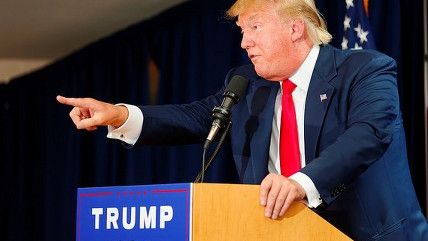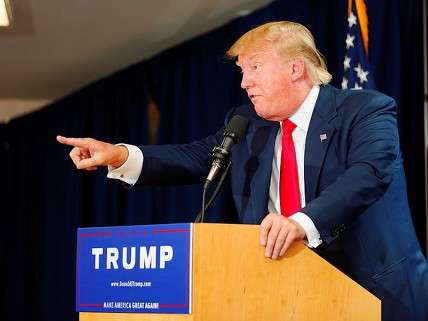Protesting Donald Trump is Now a Federal Crime
As is protesting any candidate with Secret Service protection.

The Orwellian-named "free speech zones"

on college campus and political rallies are nothing new to regular readers of Reason, and suppressing political dissent with the brute force of government has been a feature of the American system since shortly after 9/11/01, when the Secret Service and local law enforcement entities began confining demonstrators to "protest zones."
What might be a surprise is the fact that quietly and right under our noses in 2012, Congress nearly unanimously passed H.R. 347 (a.k.a. the Federal Restricted Buildings and Grounds Improvement Act) which makes it a federal crime punishable by up to 10 years in prison to "willfully and knowingly" enter a restricted area or to engage in "disorderly or disruptive conduct" that in any way impedes "government business or official functions."
Signed into law by President Obama, this supposed tweak of a pre-existing law effectively criminalized protest of any person under the protection of the Secret Service, a select group which includes both major parties' front-runners for the presidential nomination. During the general election, the nominees of both parties are automatically assigned Secret Service protection, but Hillary Clinton, as a former first lady, is entitled to a Secret Service detail for the rest of her life, and Donald Trump has had a detail assigned to him since last November.
Dahlia Lithwick and Raymond Vasvari wrote in Slate that "the law makes it easier for the government to criminalize protest. Period." They also assert the words "disorderly" or "disruptive" could be defined down to mean almost anything with regards to "impeding government business."
And it's not just presidential campaign events where free speech is so severely restricted:
Today, any occasion that is officially defined as a National Special Security Event (NSSE) calls for Secret Service protection. NSSE's can include basketball championships, concerts, and the Winter Olympics, which have nothing whatsoever to do with government business, official functions, or improving public grounds. Every Super Bowl since 9/11 has been declared an NSSE.
Now that Donald Trump's staff is having local police forcibly remove protesters from campaign events before they even speak, the question has to be asked: Why are the police cooperating with such requests?
In this video, the expelled group of almost exclusively black demonstrators outside the Valdosta State University (VSU) arena tell an officer that they are students of the school and paid to attend the event.
The officer replies, "This is your college campus but this part has been rented out." Another officer tells them he has no idea what the group supposedly did to disrupt the event (and no video evidence has yet emerged showing they did anything except dress in black and wait for the event to start), but that the Trump staff asked that they be removed and that they are free to protest in a designated free speech zone far from the event itself.
In a letter to the VSU community, interim university president Cecil P. Staton conceded that the removal of the students was "disturbing," but passed the buck entirely by stating that "this was not a VSU sponsored event, but a private function."
In defending the suppression of the basic right of free expression of his students by government forces, Staton added:
The Trump campaign, together with the Secret Service and other law-enforcement officials, had responsibility for such decisions, not VSU. As we reminded the campus via email last Friday, current federal law (HR 347) does not allow for protesting of any type in an area under protection by the Secret Service.
Last month, days before the New Hampshire primary, I reported from the GOP debate in Manchester, where Republican demonstrators and anti-Trump protesters were confined to a "free speech zone" on an icy hill more than a mile from the assembled media. Read the article here or watch the video below.


Show Comments (48)